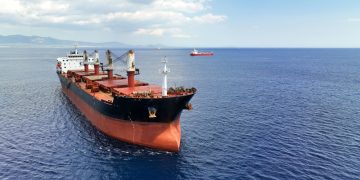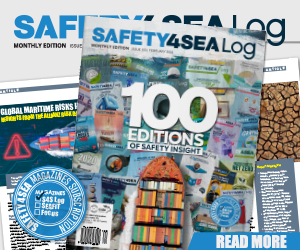The IMO Navigation, Communications and Search and Rescue Sub-Committee (NCSR) 10, took place 10 to 19 May 2023 where matters related to the safety of pilot transfer arrangements were discussed, highlighting the need to revise SOLAS regulation V/23.
Lloyd’s Register has issued a report with key outcomes from the committee. Below are some of the changes to current requirements which were discussed at NCSR 10 and will have some impact on current practices:
Key outcomes:
- NCSR 10 agreed to amend SOLAS V/23 and develop a separate mandatory instrument which will include the fundamental provisions for design, installation, inspection, maintenance and rigging of pilot transfer arrangements.
- NCSR 10 also began the work to develop performance standards for a digital navigational system (NAVDAT) which is mooted to be the successor to NAVTEX. However, NCSR 10 agreed that a cautious approach was necessary and will continue the work at NCSR 11.
- NCSR 10 revised 1/Circ.32/Rev.1 Harmonisation of GMDSS Requirements for Radio Installations on board SOLAS Ships to take account of identified discrepancies, gaps and inconsistencies. The revised circular will be disseminated as Rev.2 and support the new requirements for the GMDSS which enter into force 1 January 2024.
Navigation
NCSR 10 agreed to the following recommendatory Additional Protective Measures (APMs):
- Mariners should navigate with particular caution within the NW Mediterranean PSSA, in areas where large and medium cetaceans are detected or reported and reduce their speed to between 10 and 13 knots as voluntary speed reduction (VSR). However, a safe speed should be kept, so that proper and effective action could be taken to avoid collision and any possible negative impacts on ships’ manoeuvrability.
- Mariners should keep an appropriate safety distance or speed reduction measure from any large and medium cetaceans observed or detected in a close quarter situation. The safety distance or speed reduction measure should be adapted to the actual navigation circumstances and conditions of the ship.
- Mariners should broadcast on VHF or other available means on scene, the position of medium and large cetaceans observed or detected within the designated PSSA and transmit the information and the position to a designated coastal Authority(ies).
- Mariners should report any collision with cetaceans to a designated coastal Authority(ies), which should forward this information to the International Whaling Commission (IWC) global cetacean ship strikes database.
The APMs will be referred to MEPC 80 for inclusion in the final resolution.
Draft amendments to resolution MSC.530(106) on Performance standards for Electronic Chart Display and Information Systems (ECDIS)
The amendments are expected to be approved at MSC 108 (May 2024). NCSR 10 noted that the application dates of the original resolution (MSC.530(106)) has a phased introduction from 1 January 2026, and agreed that there was no need to amend the application which is as follows:
- New ECDIS equipment installed on or after 1 January 2029.
- Systems installed on or after 1 January 2026 but before 1 January 2029 may conform to either the revised resolution or to performance standards specified in resolution 232(82).
- Systems installed on or after 1 January 2009 but before 1 January 2026 are to conform to the performance standards specified in resolution 232(82).
- Systems installed on or after 1 January 1996 but before 1 January 2009, are to conform to the performance standards specified in resolution 817(19), as amended by resolutions MSC.64(67) and MSC.86(70).
Revision of SOLAS regulation V/23 and associated instruments to improve the safety of pilot transfer arrangements
NCSR 10 agreed that:
- SOLAS regulation V/23 should be revised.
- A separate resolution containing performance standards being directly referenced in the main text of revised regulation 23 (thus making it mandatory) should be This would supersede A.1045(27).
- The footnote to regulation V/23 which references the ISO standard will be considered in the revisions to the regulation.
This work will now be continued in an intersessional correspondence group and is expected to be finalised at NCSR 11 (expected June 2024).
Communications
Development of amendments to SOLAS chapters IV and V and performance standards and guidelines to introduce VHF data exchange system (VDES)
NCSR 10 agreed that amendments to SOLAS chapter V should take priority while a more cautious approach will be needed to introduce the new communication tool under the GMDSS for the dissemination of MSI and revisions to SOLAS chapter IV. At the same time a technical, regulatory and operational analysis of VDES should be undertaken including its communication component which includes AIS, VDES-ASM, VDES-VDE- terrestrial and VDES-VDE-Satellite elements.
In order to progress the work as quickly as possible it will be continued through an intersessional correspondence group with the expectation of the amendments to SOLAS being finalised at NCSR 11 (expected June 2024). If the work is finalised at NCSR 11 as expected, then any amendments to SOLAS will enter into force 1 January 2028.
Development of performance standards for a digital navigational data system (NAVDAT)
NCSR 10 considered:
- A proposed draft MSC resolution on Performance standards for the reception of maritime safety information and search and rescue related information by MF and HF NAVDAT although due to time constraints they were unable to progress the standards.
- Proposed draft amendments to resolution MSC.509(105) on Provision of radio services for the Global Maritime Distress and Safety System (GMDSS). Likewise, time constraints meant that this work was not progressed.
- A proposed draft NAVDAT Manual. However, it was felt that it was premature to continue with the development of the manual at this stage.
- Proposals on the way forward for the introduction of NAVDAT and NCSR 10 endorsed a roadmap of elements that will need to be considered.
NCSR 10 noted that the existing system (NAVTEX) and NAVDAT would be expected to co-exist for a long time and new equipment to be developed in future would likely encompass both systems. In addition, it is expected that the provision of the NAVDAT service by coast stations would be optional so that the investment already made in NAVTEX shore infrastructure would not be lost.
Application: The work is expected to be finalised at NCSR 11 (2024) for subsequent adoption by MSC. Full application is yet to be decided.
Search and Rescue
NCSR 10 decided that it was premature to amend the IAMSAR Manual to include guidance on emergency notification devices given the growth in the number of providers of a satellite distress communication service that does not fall within GMDSS or the typical international distress alerting system.
COMSAR.1/Circ.32/Rev.2 Harmonisation of GMDSS Requirements for Radio Installations on board SOLAS Ships
As part of the longstanding project for the modernisation of the GMDSS, NCSR 9 approved revisions to COMSAR.1/Circ.32 Harmonisation of GMDSS Requirements for Radio Installations on board SOLAS Ships which was endorsed by MSC 106 as COMSAR.1/Circ.32/Rev.1. NCSR 10 considered several gaps and inconsistencies that have been identified in the text and agreed to amendments as follows:
- Deletion of the reference to SOLAS regulation IV/7.1.2 from section 1.6.3 relating to the duplication of VHF DSC watch receiver, in line with previous GMDSS requirements.
- Reviewed and updated the table under section 2.3, including the notes underneath it with the understanding that ships may choose duplicated MF/HF telephony to substitute MF telephony in sea area A3.
- Section 6.1.2 of the circular (i.e. “Interference from LED lighting and other unintentional emitters”), is reorganised to clarify the process recommended for identifying the source of electromagnetic interference, such as LED lighting systems, and by removing the reference to safety radio certificate.
- Other minor amendments and editorial changes.
NCSR 10 approved the revised circular which will be disseminated as COMSAR.1 /Circ.32/Rev 2 with an effective date of 1 January 2024. MSC 107 will be invited to endorse this action.
Unlawful practices associated with the fraudulent registration and registries of ships, including manipulation of AIS data transmissions and tampering of AIS transponders
NCSR 10 agreed to amend MSC.74(69)(Annex 3) Recommendation on Performance Standards for an Universal Shipborne Automatic Identification System (AIS) section 6.3
NCSR noted that the Guidelines for the installation of a Shipborne Automatic Identification System (AIS) (SN/Circ.227) addresses the restriction of access to the static information such as MMSI number and IMO number if the AIS is controlled by a password which makes it harder to manipulate, however this is not a mandatory document. NCSR also noted that VDES may supersede AIS in the future.
NCSR agreed to recommend to MSC that further measures could be considered and proposes that the Committee agrees to the request for a new output so that this subject can be added to the agenda of NCSR 11 as ‘Measures to improve the integrity and security of AIS’.
Man overboard incidents from fishing vessels
NCSR 10 noted the report from the III 8 sub-committee on the safety issues resulting in man overboard incidents from fishing vessels and the use of personal flotation devices (PFDs) and search and rescue transponders (SART), to relocate a person falling overboard from fishing vessels.
NCSR 10 agreed that the following should be referred to the III sub-committee:
- A SART is only useful if the person is in a vessel or survival craft owing to the physical size of the device. Further, a SART is only used for localised or line-of-sight locating;
- MOB devices containing AIS-only might be used for localised locating. AIS-SART technology can be incorporated in other MOB devices which are smaller than a SART.
- For instances where the man overboard is beyond-line-of-sight of a vessel, 406 MHz devices, such as PLB and EPIRB might be more suitable.
- SAR aircraft are encouraged to carry an AIS and/or VHF DSC receiver to assist with localised locating. Progress on standards development by IEC
Progress on standards development by IEC
NCSR 10 noted the report from IEC TC 80 on the progress of standards under development which will support performance standards and other IMO instruments. This is a standard report which included, but is not limited to the following):
- Bridge alert management which includes the document Bridge alert management for mariners (Bridge Alert Management (iec.ch))
- Digital interfaces
- GMDSS
- GNSS
- ECDIS
Delays affecting the availability of new GMDSS radio equipment from 1 January 2024
NCSR 10 supported the proposal to extend the continued installation of GMDSS radio equipment conforming to the previous performance standards until 1 January 2026, but also noted that the IEC were not expected to complete development of the relevant testing standards until that date, and an additional two years would be needed for the mass production of the relevant equipment and to bring them to market. In this respect NCSR 10 deferred any decisions to MSC 107 (June 2023).
NCSR 10 also noted that in the event of an extension being agreed at MSC 107 the Guidance on the validity of radiocommunications equipment installed and used on ships (MSC.1/Circ.1460/Rev.3) would also need to be revised.
Development of guidelines for the use of electronic record books under SOLAS regulation V/28
NCSR 10 considered a proposal to develop the necessary guidance for both the shipping industry and the Administration when approving the use of electronic record books but agreed that a request for a new output to MSC would be needed before any work could be started.

































































